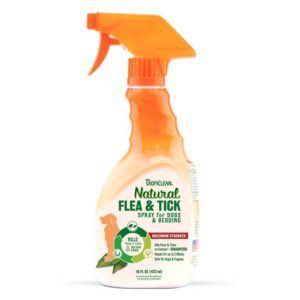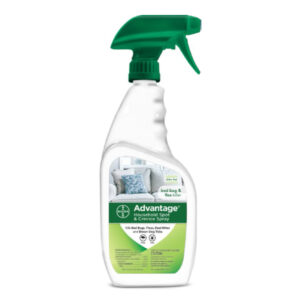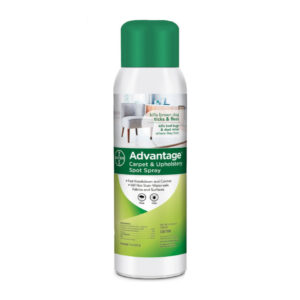
The days are just barely getting longer and the weather a little warmer- SPRING IS ON ITS WAY! As we begin to daydream about spending more time outside, it’s important to remember that we aren’t the only ones who enjoy the spring weather. Insect populations – including FLEAS and TICKS – begin to flourish, which mean we need to start thinking prevention! With the big push to become more aware of what we are consuming and how those products affect our health (or the health of our pets) and the environment, a conscientious pet owner might wonder if it is better to stick with conventional treatments or opt for something more natural. Or you might be wondering if flea and tick preventatives are really even necessary. Let’s take a look!
Flea and Tick Prevention

If left without any protective measures, your pet can become very quickly infested with fleas. A single female flea can produce up to 2,000 eggs in her three week lifespan. The fleas can cause what is known as flea allergy dermatitis – or the constant itching and scratching which can lead to hair loss and damaged skin. Even worse, if your pet is bit by an infected tick, it can transmit several different diseases, including Lyme disease. If the thought of your beloved pet being miserable with itching and scratching or sick from a tick-borne disease isn’t enough to convince you to seek a form of prevention, don’t forget, these creepy, crawlies can infest your home or even you!
Topical Flea and Tick Remedies

Conventional treatments for flea and tick prevention are available from the vet’s office and over-the-counter. “Spot on” or “hot-spot” treatments are a topically applied medication that is applied between the shoulder blades to minimize your pets ability to lick it off and potentially get sick. Some topical treatments are able to both kill fleas and ticks that bite your pet, but also repel them, so they don’t even have the chance to bite. Most spot on treatments last one month – but it is important to start treatment as a preventative. If you only start treatment once you see the first flea, you could have millions of fleas and larvae in your home and on your pet. Once the flea biomass reaches this level, it can takes weeks to months to fully eradicate the problem. When used properly, monthly applications of a topical flea and tick preventative is 88.4 percent effective.*
Flea and Tick Medication or Chew-able Treatments
If you are looking for a more effective conventional treatment, a pill or chew-able flea and tick medication might be what you are looking for. They are available at your vets office or over-the-counter. When used properly this method can be up to 99.9 percent effective*. Some of the chew-ables can be used for routine prevention, while others are shorter lasting, and primarily used to treat a flea infestation once it has already taken hold. It is important to note, that most of these options are used for fleas only. The active ingredient nitenpyram is found in the fast acting pills and is the only chew-able that can also kill ticks. In addition to being more effective, a chew-able pill is less likely to cause irritation to your skin, should you accidentally pet your dog or cat before the treatment has been fully absorbed.
Flea Collars

Conventional flea and tick prevention also comes in collar or shampoo form. Many of these options use the same active ingredients in the spot-on treatments. Collars might be less irritating to your pets’ skin, seeing as the ingredients are not actually absorbed. Shampoos can be made with convention and alternative active ingredients. This option would work best if used after being outside or in a heavily wooded area. They do a great job of killing any pests hat might have hitched a ride on your pet, but their effects are not nearly as long acting so they will not work as well for prevention.
Things to Consider with Conventional Flea and Tick Treatments
As effective as these conventional options might be, they do carry some risks. Most notably, they are made from pesticides which can cause an irritation or allergic reaction for you or your pet. The chew-able pills can also cause digestive upset. Neither of which would be fun, but still better than fleas or ticks. So let’s look at some alternative options, to see how they measure up.
Natural Flea & Tick Remedies

Most natural and non-toxic flea and tick repellents are made with essential oils – the volatile compounds found in plants that give them their aromas. While essential oils are considered a non-toxic alternative to chemically derived products, they can be harmful to you or your pet if not properly diluted or if an oil that is not safe for dog or cats is used. Some DOG safe essential oils that repel fleas and ticks include lavender, lemon, citronella, clary sage, cedar wood, lemon eucalyptus, peppermint, and rose geranium. CAT safe oils that repel insects are lavender, clary sage, and cedar wood. These can be used individually, but they will typically be found in combinations to increase the effectiveness. Commercially made essential oil based products, such as shampoos, sprays, and collars can be found in most pet stores; but you can also make a blended spray yourself. If you chose to make it yourself, be sure to properly dilute the essential oils in a carrier oil and water. It is also VERY important to know if you have both cats and dogs, that cats are extremely sensitive to essential oils. You should never use a dog safe essential oil blend on, or even in the vicinity of, your cat unless you have double checked the ingredients for cat safety.
Another natural option for flea and tick prevention is a blend of diatomaceous earth powder and neem powder. Diatomaceous earth or diatom flour is a powdery soft substance that comes from the fossilized skeletons of an aquatic creature. It kills insects by puncturing the exoskeleton and causing death by dehydration. It is harmless to humans and pets, but deadly to insects. Neem powder is an herb that has been used very effectively as an insect repellent, including fleas and ticks. It inhibits the insects ability to develop and therefore halts its life cycle. As an added benefit, neem is very moisturizing and can help calm irritated skin. If you decide to give this option a try, it is always best to opt for food grade ingredients.
If you are ever unsure about the best treatment and prevention option for your pet, it is best to seek advice from your vet. When it comes to conventional options, the dosing and active ingredients are very important. Using the wrong dose can lead to decreased efficacy or increased risk for irritation or reaction. Certain active ingredients are approved for dogs of a certain age but can be very harmful to younger puppies or cats of any age. Just like the conventional options for fleas and tick prevention, natural options should be discussed with a knowledgeable professional to insure that the combination of oils is safe for your pet. Just because the oils are listed as dog or cats safe, it might interact with your pets’ other medications or health conditions. These options, while proven effect through historical and anecdotal evidence, do not have clinical trials to prove their efficacy. They also might not be enough protection if you live in or visit heavily wooded areas that are more abundant in fleas and ticks.
Sometimes the best solution is a combination of conventional and natural options for complete flea and tick prevention. So whether you protect your pet with conventional or alternative options, or some combination of both, just remember that when you think spring, think flea and tick prevention, too! *statistics published in Veterinary Parasitology, Volume 191, Issues 3-4, 31 January 2013, pages 340-346



